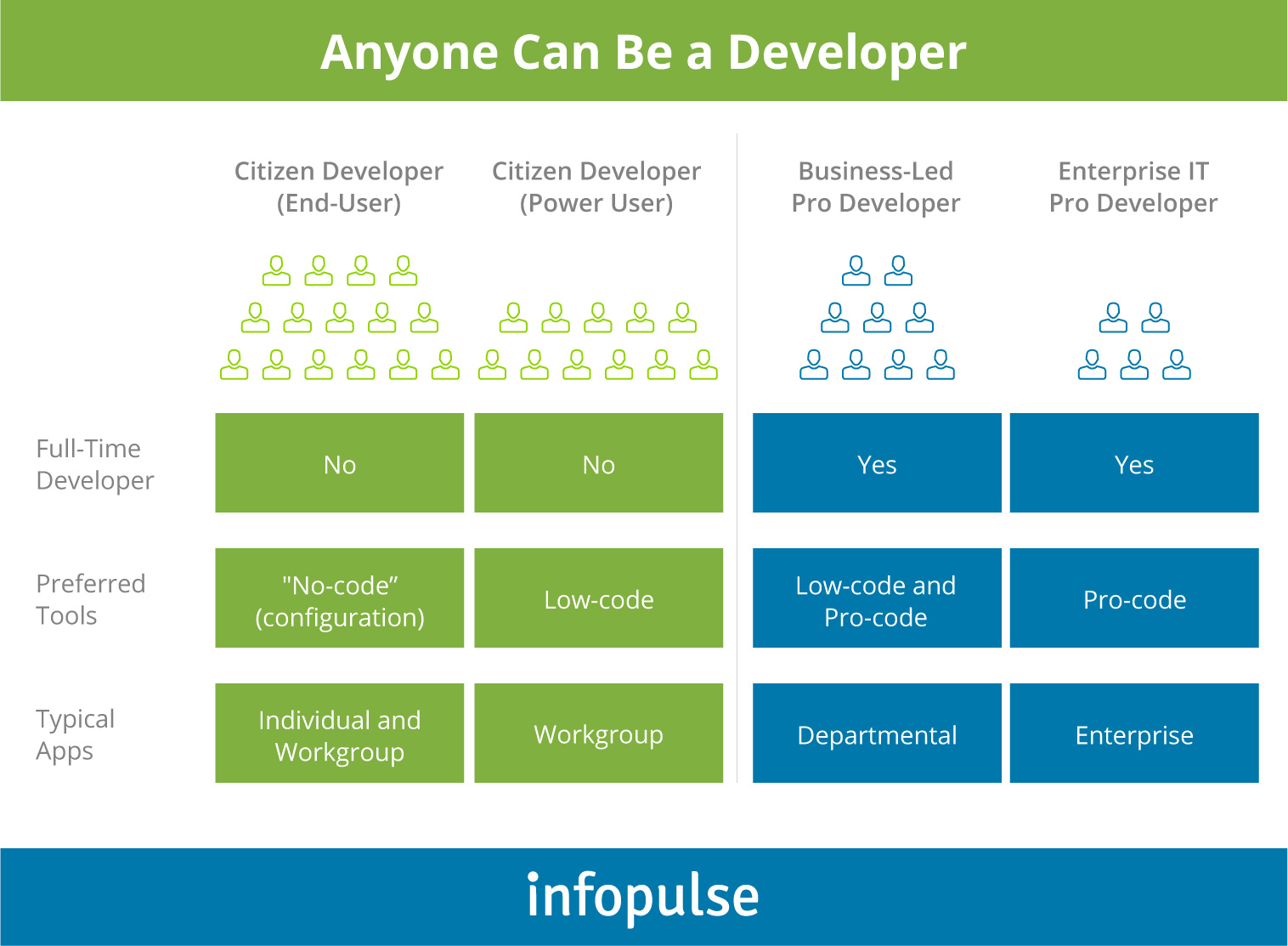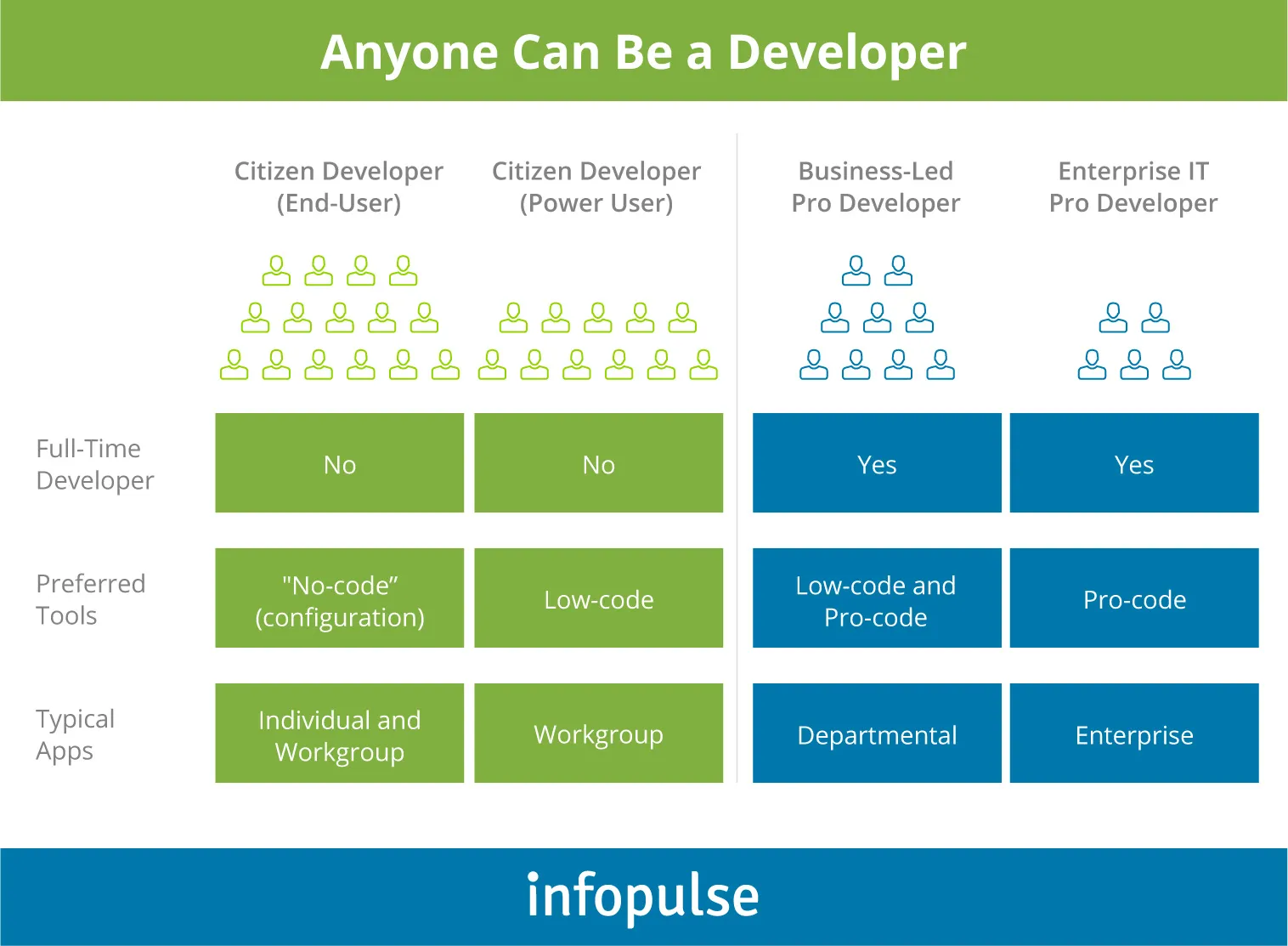Why Low-Code Isn’t Just for Citizen Developers
Blog: ProcessMaker Blog
Developers may be highly skilled and experienced, but they still realize that hand-coding is outrageously time-consuming. When businesses need to meet growing needs, it’s difficult to retain enough software developers to fulfill demand. Applications miss their deadlines and quality suffers. As a result, the popularity of low-code is on the rise. Further, citizen developers are already using low-code to create custom business apps and more. According to Gartner, low-code will comprise over 65% of application development by 2024. So, what is low-code and why isn’t it just for citizen developers?
What is low-code?
As people live and manage more of their lives digitally, the demand for new software will continue to rise. Moreover, the COVID-19 pandemic has turned remote work from a niche trend towards becoming the new normal. Invariably, the demand for new applications is skyrocketing.
Low-code uses automation to manage coding, debugging, testing, and application deployment. The low-code platform, or Integrated Development Environment (IDE), creates the application and offers the workflows and features to automate testing, debugging, and deployment either on premises or on the cloud. Then, after deployment, the application is managed and run by the platform.
Using a low-code platform can flush out high quality applications
Low-code platforms offer visual diagrams, drag and drop interfaces, and connectors to create workflows, entities, and relationships. In addition, they provide event, action, and process definition. In the background, the platform writes the software, backend databases, business logic, and designs the user interface. Next, the applications can be built, tested, and deployed in the cloud.
It’s similar to rapid application development (RAD) tools like Visual Studio or Delphi where developers can access a visual designer to drag and drop a list of visual objects and then configure properties, actions, events, and data models.
The many benefits of low-code
The demand always trends up in terms of getting things built faster and cheaper, without sacrificing quality. Low-code helps developers reach that objective by offering the ability to reduce turnaround time and write code more quickly. Indeed, with low-code, creating high-quality apps takes less time and requires fewer resources.
Unquestionably, hand-coding under time pressures will often lead to errors that can affect application performance, reliability, availability, and usability. Some development teams may vary in terms of experience and background, therefore producing inconsistencies in code quality. Over the long-term, low-quality coding can spell disaster.
Using a low-code platform means that cyber security is already baked in based on industry standards and best practices. If the goal is to produce high-quality code at a rapid clip, low-code is the solution.
Also, developers enjoy the fact that low-code platforms are extensible and flexible. Low-code can be used to extend functionality of existing applications. You can also integrate third-party APIs without having to write any code. Read more about extending low-code platforms with API Driven Architecture in Business Process Management
Not to mention that if CI/CD practices are not already part of the application workflow, then building, testing, and deployment becomes even more time-consuming and even clunky. However, a low-code platform automates testing and deployment to ensure a quicker delivery cycle.
Enhance the development process

There isn’t any reason for developers to fear the activity around interface element dragging and dropping. It may take some getting used to for developers who love outdated tactics for delivering software. Once developers get the hang of a low-code platform, it becomes enjoyable to generate code quickly. In terms of optimizing the software development workflow, a low-code platform is more cost-effective than hiring four or five more software developers. And, a low-code platform can easily integrate with existing infrastructure.
These days, every development team wants to be “agile.” Who doesn’t? Before low-code, the software development cycle would include prototyping to demonstrate the product to the intended users. On the other hand, low-code eliminates the need for prototyping because the drag-and-drop interface means developers can create a working application in the same amount of time it used to take just for prototyping.
Merge conflicts are stressful. What’s a merge conflict? Well, prior to low-code, developers would separate their incompleted code via version control system from finished software products. When new code is ready to be added, developers need to use the master branch to merge the updates. And, some developers may change the files once again but version control systems can tell which changes to add and which to delete. So then, you get undesirable merge conflicts.
Here are some other reasons why low-code isn’t just for citizen developers:
- Cross-platform: Low-code platforms are often built to deploy applications across a wide variety of platforms. Developers can use HTML or even JavaScript. All it takes is a single codebase to create applications for the mobile and desktop space. Write once, and run everywhere.
- Integrate seamlessly: Before software deployment is said and done, often developers have already tried to integrate data stores, third-party APIs, and open-source libraries. Unfortunately, each iteration needs new code to manage the requirements of every dependency – and, the code does require maintenance. Yet, low-code offers templates and instant connection logic.
- Reduce the workload: Developers can’t resist their need for speed. As mentioned in several of the points above, quick deployments mean developers can amplify their workflows. It’s the write-once-run-everywhere paradigm that is appealing. Reduce the time it takes to hand code, eliminate bugs, and maintenance requirements. What’s not to love? Low-code reduces the time-crippling slowdowns of manual coding and testing. When developers use low-code, they feel free.
- Quick turnaround: In contrast to the alternative, low-code is easy to use and learn. Developers don’t have to worry about learning a new programming language. Low-code is as easy as drag-and-drop. Getting up to speed with low-code is rather quick.
- Deploy rapidly: Unquestionably, application projects can be very complex. Deployment processes are also quite complicated. At times it involves a shell script to package the master code, send it to the servers, and hope for a successful callback. And, deployment might require maintenance to perform backups and upgrade the databases. In contrast, low-code takes care of a majority of the DevOps tasks. The hard work is taken care of so developers can work on projects they enjoy.
Low-code decreases the average workload and takes the pressure off developers. The code is reusable for any app as necessary. Since the code is reusable, developers will notice a significant decrease in application time-to-market. Low-code also saves time around testing, implementing security, and verifying reliability. Further, application development is truly scalable while developers can easily clear out their backlog and streamline their workflows.
Use the low-code advantage
Indeed, most code will be managed and written on low-code platforms in the future. Using visual IDE components saves on time, resources, and complexity. Once a low-code application is built, use a few clicks to debug, test, and deploy. Unquestionably, there is a reason why low-code isn’t just for citizen developers. It is the means for getting more done in less time. And, developers will have the ability to focus on strategic applications. If you’re interested in learning more about how low-code can optimize your development cycles, Processmaker is here to help.
The post Why Low-Code Isn’t Just for Citizen Developers appeared first on ProcessMaker.
